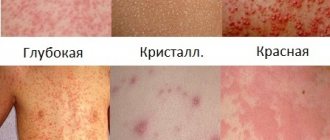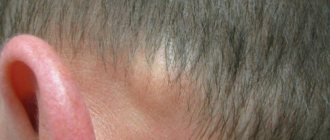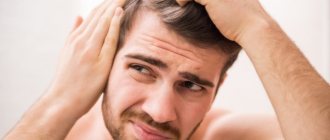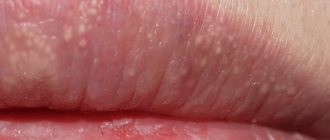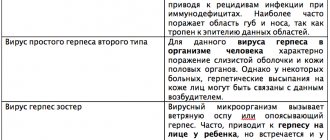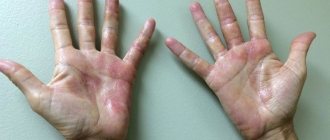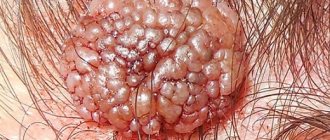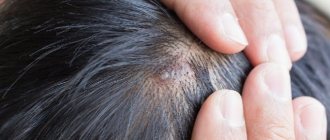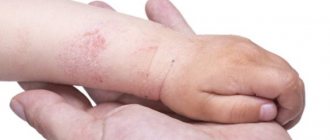What is eczema
Eczema is an inflammatory skin disease that manifests itself as a rash, itching, and redness. The rashes can take a wide variety of forms, affecting different parts of the body. The disease is not contagious. Eczema is often recurrent.
The mechanism of inflammation developing in the dermis and epidermis is that a certain group of cells, when irritated, release substances that cause inflammation. The latter in turn causes itching. The patient itches - inflammation intensifies, microbes penetrate, which together leads to systemic disorders.
Eczema is a polyetiological disease, that is, it is not possible to name a reliable root cause of this pathology. As a rule, this is a combination of exogenous and endogenous factors, the main of which are:
- weakness of the immune system;
- tendency to allergic reactions;
- nervous disorders;
- metabolic disorders in the body;
- genetic predisposition.
According to statistics, this type of dermatitis most often occurs in women aged 30–40 years. This is probably due to high emotional lability (women are more often nervous), as well as frequent contacts with potential allergens: cleaning products, detergents, cosmetics.
Prevention
To prevent crusts on the head from appearing again, prevent seborrhea. It should be as follows:
- proper nutrition;
- choosing a suitable shampoo, preferably with zinc and ketonazole;
- regular examination at the clinic;
- control of stress and chronic diseases.
These recommendations will help your body stay in shape. By taking preventive measures, you can prevent the recurrence of seborrhea for a long time, and perhaps forever. See also video on the topic.
The main types of eczema that can occur on the scalp
There are wet and dry forms of eczema. The latter most often manifests itself on the hands and fingers, and the ingress of water onto the affected areas significantly aggravates the condition. The weeping form is accompanied by a large amount of serous discharge with the resolution of small vesicular rashes, papules, and pustules.
The following types of eczema can be localized on the scalp:
- seborrheic;
- mycotic;
- true;
- microbial;
- sycosiform.
Let's take a closer look at what each variety is and how it manifests itself.
How to get rid of crusts forever
This is a curable disease, regardless of the stage of development. Therefore, never neglect treatment and act immediately.
When crusts appear on the head of an adult, it is important to understand that you are dealing with a serious fungal disease. By ignoring this fact, the patient risks being left without hair or acquiring blood poisoning. Of course, such an outcome will affect anyone who does not see a doctor in time. After examining the patient's condition, the doctor will likely prescribe the following:
- Antiseborrheic shampoo (sebazole, nizoral) for mild forms of the disease.
- Anti-fungal ointment for itching and inflammation (dexamethasone, afloderm, silcaren)
- Antibiotics for seborrhea in especially advanced cases (curiosin, regetsin, keto plus).
An antifungal ointment is perfect for treating the skin in this case. It suppresses mycospores. A cotton sponge is used to apply to the skin. As a result, you will see that there will be less fungus, there will be no itching and inflammation will decrease.
Also, medicated shampoo is no less effective. To feel its effectiveness, it is important to maintain a course of use for two weeks until symptoms completely disappear. It is necessary to follow a diet, give up flour, sweets, soda, and citrus fruits.
We recommend paying attention to the following medications:
- Sulsena is a favorite drug that has a beneficial effect on the skin, while reducing the level of fungus and normalizing the functioning of the sebaceous glands. In addition, it helps to painlessly exfoliate crusts from the scalp, and then the restorative effect is triggered. Used in the form of shampoo or paste.
- Naftaderm - the main component is refined naftalan oil. The ointment is excellent for treating any disease where crusts appear on the head. Apply twice a day for four weeks.
- Salicylic ointment is a good antiseptic with regenerative properties. Dry crusts soften under the influence of this ointment and inflammatory processes are additionally relieved. Treatment time is about two weeks. The cost is low, but the product is irreplaceable in its kind.
But if the previous drugs did not give the desired effect, you should undergo a course of treatment with more professional methods:
- Photochemotherapy – UVA irradiation; taking drugs that create fluorescence. The course of treatment is divided into two stages: cleansing and further support.
- The use of Darsonval has proven its effectiveness in cosmetology in the treatment of dermatitis on the face, body and head. The currents of the device inhibit the activity of the sebaceous glands, reduce sensitivity from irritation, and have a bactericidal effect due to ozonation. The procedure takes from 5 to 15 minutes. The cycle of therapeutic activities includes from 10 to 25 sessions every day or every other day. Repeated cycles of therapy take place after 2 or 3 months.
True eczema
It is developing rapidly. Small scattered bubbles appear, which soon, sometimes within several hours, open. A serous secretion is released, foci of weeping are formed, crusts, peeling, peeling of crusts, and open wounds appear. Each of the stages of eczema is rapidly replaced by the next: erythematous - papulovesicular - weeping - cortical.
In parallel, fresh vesicles and papules with serous content may appear in another area, since the process is rarely limited to one area. Characteristic is the symmetry of the rashes and the tendency of the rash from the scalp to the skin of the upper, lower extremities, and torso. There are no clearly defined lesions.
True eczema is accompanied by severe itching, which can cause neurosis and insomnia.
Traditional methods
Traditional medicine has also succeeded well in treating scalp diseases. In addition, such methods have stood the test of time and have proven their effectiveness over many generations.
A decoction of oak bark will provide high-quality treatment aimed at getting rid of seborrheic dermatitis.
To prepare the infusion, you need to take a tablespoon of crushed bark , pour in 0.4 liters of boiling water and keep in a water bath for 5 minutes.
Before use, add a teaspoon of honey. Treatment with this decoction is carried out by rubbing into the scalp up to three times a day.
A very easy to use, but no less effective way is to rub kombucha into the scalp . It is enough to do this procedure for a month to completely get rid of crusty dandruff.
A medicinal ointment that contains a tablespoon of crushed golden mustache leaves and olive oil, a tube of baby cream, and a teaspoon of valerian tincture will also be effective. This ointment should be used to treat lesions with seborrheic dermatitis. It has a complex therapeutic effect.
Treatment of scalp eczema
Curing eczema on the scalp is quite difficult. Firstly, eczematous wounds are difficult to treat. Secondly, patients most often consult a doctor when the disease has already taken on a complex form and a secondary infection occurs. The reason for this lies in the same “insidiousness” of the disease, especially when it comes to eczema of the scalp: localized in the crown area, such lesions are difficult to detect. Simply put, the disease goes unnoticed for some time: itching is considered an accident, flaking is considered dandruff.
Mycotic infections can complicate the course. In this case, treatment will not bring results; preliminary antimycotic therapy is necessary. To do this, you need to determine the type of fungus that has settled. If the fungal component of the process was not excluded before starting treatment, then hormonal ointments and antibiotic-based ointments, which are used to combat eczema, will lead to active reproduction and mutation of fungi, if present. Therefore, in the treatment of eczema, you cannot do without consulting a dermatologist or trichologist.
As a rule, complex therapy is prescribed and may include the use of:
- hormonal ointments;
- antibiotic-based ointments;
- antihistamines;
- sedatives;
- desensitizing drugs;
- diet.
During treatment, it is also important to visit a specialist who will monitor the progress of the disease. In no case should you independently extend the prescribed course of treatment - corticosteroid hormones can cause serious side effects if used uncontrolled.
Reasons for appearance
The main cause of the appearance of dandruff crusts, as well as other diseases of the scalp, is a yeast fungus , the population of which is increasing as a result of various factors. The disease itself is interpreted as epidermal cells that have become obsolete.
With the normal functioning of all body systems, exfoliation occurs in acceptable quantities and due to daily washing of the hair and scalp, it is practically not noticeable. But if the body undergoes disturbances, then the process of cell death occurs much more intensely.
As a result, a person observes such a phenomenon as dandruff. However, if there is not just an increased population of white scales, but a crust of dandruff on the head, quite dense in structure, then this is a signal of the presence of diseases such as seborrheic dermatitis or psoriasis .
It is noteworthy that, unlike dandruff, these diseases are inflammatory in nature. Factors that influence the formation of seborrheic dermatitis are:
- consumption of an abundance of fatty, fried and salty foods;
- hormonal disorders caused by pregnancy, menopause, ovarian disease in women and testicular tumors in the male population;
- being severely overweight or obese;
- diseases that are infectious in nature;
- weakening of the immune system;
- disturbances in the functioning of the nervous system that are caused by stress or overwork;
- gastrointestinal diseases that are not infectious diseases, as well as metabolic disorders;
- disturbances in the functioning of the endocrine system;
- consumption of alcohol and tobacco products in excess quantities.
Symptoms of seborrheic dermatitis are, first of all, the presence of itching sensations. If the problem is not identified in time, the itching increases and a crust of white dandruff appears. In advanced stages, the disease is characterized by the presence of a bacterial type infection .
Attention! The result of a progressive disease can be profuse hair loss, which threatens subsequent baldness!
Unfortunately, diseases of this type are not self-medicating . In getting rid of seborrheic dermatitis and psoriasis, pharmaceutical preparations and traditional medicine will come to the rescue.
Look at the photo below what crusty dandruff looks like on the head of an adult:
Tips for those suffering from eczema
If you have a genetic predisposition or have already experienced eczema, you should be extremely careful by following these recommendations:
- avoid wearing clothes made of synthetic, wool or flannel fabric;
- include in your diet more vegetable dishes, boiled meat, fermented milk products, fruits (except for those that can provoke allergies: oranges, strawberries, raspberries, tangerines);
- avoid gastronomic experiments, alcohol, too spicy, salty and fatty foods, marinades;
- take vitamin complexes, in particular vitamins A and B are important;
- avoid contact with suspected allergens in everyday life (powders, detergents, etc.);
- in case of a history of varicose veins, wear rubber stockings and bandage the legs with medicinal bandages;
- be as nervous as possible;
- Visit a dermatologist periodically.
At the MediLife clinic in St. Petersburg, highly qualified experienced dermatologists and trichologists receive treatment. You can make an appointment online. Prices for services are presented on the website. You can clarify any details by phone. Friendly staff, the ability to choose a convenient time to visit and complete anonymity are pleasant and significant additions to the qualified consultation that will be provided at MediLife.
